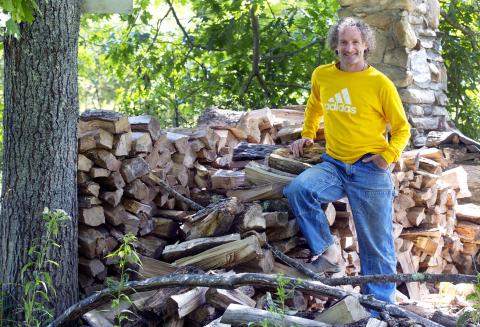In 2012, freelance journalist Theo Padnos slipped into Syria to cover its unfolding civil war and was promptly kidnapped by members of an al-Qaeda branch.
Convinced he was a CIA agent because he spoke Arabic, the group held the Massachusetts native for nearly two years before releasing him in August 2014.
Now, Padnos is retracing his journey in Theo Who Lived, a documentary being screened on Sept. 30 in Cambridge, Massachusetts. Its theatrical premiere is in New York City on Oct. 7, followed by a wider release.

Photo: AP
Padnos, 47, who has been living in Paris and Vermont, tells the Associated Press he’s grateful to have survived.
The ordeal not only changed his outlook on life but also gave him perspective on the Syrian conflict that he feels is important to share.
Padnos is working on a nonfiction book, a play and a novel drawing on his experience. He wrote about his captivity for the New York Times Magazine shortly after his release and is trying to continue writing about the region as a journalist.
“I had a real spiritual voyage, which was terrifying for me and my family at the time,” Padnos said from his family’s vacation home in Vermont. “But looking back, this is what life gave me and I’d like to take what I learned and turn it into some positive benefit.”
CLINGING TO HOPE
The film follows Padnos as he returns to places in Turkey and Israel that figured prominently in his 22-month capture. The film crew never set foot in Syria. Padnos reflects on his captivity on sets emulating his tiny prison cell and the room he was subjected to torture and beatings.
Along the Turkey-Syria border, he recalls the moment when his travelling companions instruct him to dash across the field and hop the razor wire fence separating them from Syria.
It’s a moment Padnos says he’d replay in his mind for months after.
The trio of men had claimed they were providing supplies to the Free Syrian Army and offered to take him across the border with them. But they were actually affiliated with al-Qaeda. They staged a fake interview, beat him and took him hostage shortly after crossing the border.
“This is where I threw my life away. It’s like a precipice that I walked up to and I actually jumped,” Padnos says in the film. “Now I’m back in a safe place and I’m thinking why did I ever jump?”
Padnos also details a series of failed escapes, including one in which cellmate and American photojournalist Matthew Schrier managed to sneak out through a narrow prison window but Padnos could not.
Padnos’ mother, Nancy Curtis, who is interviewed in the documentary, says she still has mixed emotions about her son’s release. During the ordeal, she became close to the parents of other Americans kidnapped by extremists overseas. Many of them were not as fortunate as her family, she says.
Curtis and other family members, working with the US and Qatari governments, successfully arranged for Padnos’ release just days after the Islamic State beheaded New Hampshire journalist James Foley in a video. The family maintains that no ransom was paid.
“I always clung to the hope that he’d come home,” Curtis said. “But I also don’t feel great joy and happiness. Probably anyone who has had a solider in the war who came home but knows others that didn’t have similar emotions.”
‘VERY HUMAN’
Director David Schisgall says Padnos’ story is a rare eyewitness account of life inside a jihadi group by an outsider with a deep understanding of the region’s language and culture.
Having spent years prior studying Arabic and Islam in Yemen and Syria, Padnos was able to build trust and friendships with some of his captors.
Near the end of his captivity, he was given greater freedoms and even traveled personally with the then-high commander of al-Nusra Front, an al-Qaeda affiliate in Syria.
“The real intimacy he developed with his captors was remarkable,” Schisgall said. “It’s a very important message for Americans to see these people fighting as complicated individuals who are both very dangerous but also very human.”

Many people noticed the flood of pro-China propaganda across a number of venues in recent weeks that looks like a coordinated assault on US Taiwan policy. It does look like an effort intended to influence the US before the meeting between US President Donald Trump and Chinese dictator Xi Jinping (習近平) over the weekend. Jennifer Kavanagh’s piece in the New York Times in September appears to be the opening strike of the current campaign. She followed up last week in the Lowy Interpreter, blaming the US for causing the PRC to escalate in the Philippines and Taiwan, saying that as

Nov. 3 to Nov. 9 In 1925, 18-year-old Huang Chin-chuan (黃金川) penned the following words: “When will the day of women’s equal rights arrive, so that my talents won’t drift away in the eastern stream?” These were the closing lines to her poem “Female Student” (女學生), which expressed her unwillingness to be confined to traditional female roles and her desire to study and explore the world. Born to a wealthy family on Nov. 5, 1907, Huang was able to study in Japan — a rare privilege for women in her time — and even made a name for herself in the

This year’s Miss Universe in Thailand has been marred by ugly drama, with allegations of an insult to a beauty queen’s intellect, a walkout by pageant contestants and a tearful tantrum by the host. More than 120 women from across the world have gathered in Thailand, vying to be crowned Miss Universe in a contest considered one of the “big four” of global beauty pageants. But the runup has been dominated by the off-stage antics of the coiffed contestants and their Thai hosts, escalating into a feminist firestorm drawing the attention of Mexico’s president. On Tuesday, Mexican delegate Fatima Bosch staged a

Would you eat lab-grown chocolate? I requested a sample from California Cultured, a Sacramento-based company. Its chocolate, not yet commercially available, is made with techniques that have previously been used to synthesize other bioactive products like certain plant-derived pharmaceuticals for commercial sale. A few days later, it arrives. The morsel, barely bigger than a coffee bean, is supposed to be the flavor equivalent of a 70 percent to 80 percent dark chocolate. I tear open its sealed packet and a chocolatey aroma escapes — so far, so good. I pop it in my mouth. Slightly waxy and distinctly bitter, it boasts those bright,